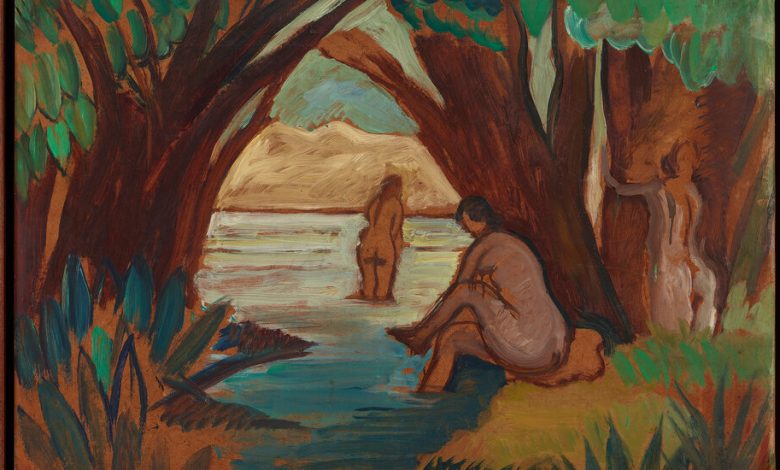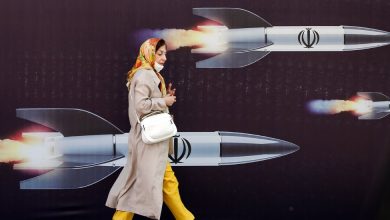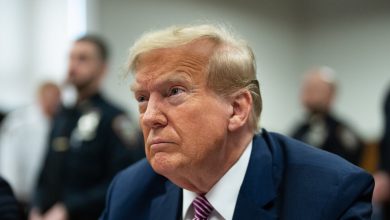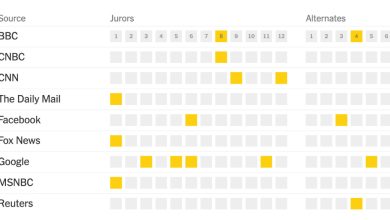Spotlighting the Body in a Nascent Arab Art World

The subject of the painting lies naked on crumpled, white bedding. Her shapely breasts sit high, her ankles crossed.
Art aficionados may be imagining Édouard Manet’s celebrated “Olympia,” from 1863, currently on view at the Metropolitan Museum of Art. The work in question — “Nude Lying in Front of a Porthole” — was painted 60 years later, by the Egyptian artist Georges Hanna Sabbagh, one of many 20th-century Arab artists laying claim to famous European nudes.
Sabbagh’s work is included in an exhibition uptown, at Columbia University’s Wallach Art Gallery, titled “Partisans of the Nude: An Arab Art Genre in an Era of Contest, 1920-1960.” The show spotlights 85 rarely seen works in the nude genre, including paintings, sculptures and drawings created after the fall of the Ottoman Empire in 1922, as Arabs transitioned from living under British and French rule to independence. The exhibition raises several questions: What is considered nude art? Who gets to create it? And what does it mean to be Arab?
It also challenges the long-held notion, promoted by the art historian Kenneth Clark in the 1950s, that the nude is inherently a Western genre, beginning with the Greeks, through 15th-century Italy. Kirsten Scheid, the show’s curator, argues that creators the world over universalized the tradition and expanded upon it.
That includes Arab artists, despite religious and cultural restrictions they may have come up against. The Hadith, the sayings and traditions of the Prophet Muhammad, features a prohibition against the visual depiction of living things. But in the secular sphere, that prohibition has been interpreted differently across cultures over centuries.
Even rules about modesty and dress in Islamic law — for instance, that women and men should conceal intimate body parts — cannot be traced to a clear-cut scroll, said Sarah Eltantawi, an associate professor of modern Islam in the department of Theology at Fordham University. Rather, they stem from debates among Muslim scholars who, reflecting on texts in the Hadith and the Quran, reached a consensus.
But that doesn’t mean those rules were enforced. “As with everything,” said Margaret Graves, an associate professor of Islamic art and architecture at Brown University, “there’s the theory and then there’s the reality of actual, kind of lived practice that changes all the time.”
Most conversations about the history of nude art may gloss over the Middle East, although such works existed in the region hundreds of years ago. Graves points to three sites dating to the eighth century.
One of them, Quseir Amra, a palace in present-day Jordan, is decorated in frescoes depicting various figures, including nude women. Up until the site was rediscovered in the 19th century, Graves said, the story of art in the early Islamic world “had been based on the idea that there was no depiction of people, and certainly no nudity.”
Graves also cited sculptures of partially nude women found at Khirbat al-Mafjar and Qasr al-Mshatta, two other palaces in the region. A drawing of a partially nude courtesan, reportedly found in present-day Cairo, likely dates to the 10th to 12th centuries. After that period, other widely known nude artworks in the Middle East don’t appear until the spread of erotic manuscripts in the Ottoman Empire, Graves said.
In the late 19th and early 20th centuries, as the Ottoman Empire was declining and European rule was slowly making its way into the Middle East, many Arab countries were undergoing a cultural renaissance, or the Nahda, said Eltantawi.The “flourishing of nudes,” evident in the Wallach exhibition, she added, was a product of that moment of curiosity and openness.
Around the same time, Muhammad Abduh, an Islamic reformer and then the Grand Mufti of Egypt, traveled to Europe and wrote of his astonishment with its museums and scientific institutes. He then issued a religious edict, or fatwa, that allowed image-making and the depiction of living beings for scientific and educational purposes, so long as it did not lead to idolatry.
“This is the most pivotal moment in the history of Arab art,” said Sultan Sooud Al Qassemi, the founder of the Barjeel Art Foundation, which provided support and works to the Wallach exhibition. While Abduh did not mention nudes, many artists saw his edict as a green light to paint bodies, said Eltantawi.
Scheid, a professor of anthropology and art studies at the American University of Beirut, and a visiting lecturer at Columbia, said she began researching nude works by Arab artists because she had long been told they did not exist, yet had also heard of exceptions. Though most of the pieces on view were shown briefly when they were created, they were then kept in private collections, largely because administrators of public collections assumed some communities might object.
Scheid focused on the period of 1920-1960, a defining moment for Arabs who were decolonizing from European mandates but could not return to what was before, an era that “reeked of Ottoman patronage.”
“There wasn’t anything left in a sense that could clearly be claimed as Arab,” Scheid said.
The artists on view represent various countries and faiths, and many were practicing Muslims. Some pieces feature references to religion, both directly and indirectly.
In a 1932 painting, “At the Exhibition,” by the Lebanese artist Omar Onsi, veiled women gather around a nude artwork. In Scheid’s view, the painting captures how Muslims were engaging with their faith and rethinking what it meant to be Muslim at the time.
“The paintings were teaching people how to make sense of each other,” she said.
In the abstract self-portrait “Subhan (May He Be Glorified),” from 1949, the Lebanese Druze artist Saloua Raouda Choucair draws herself alongside Ibn Rushd, the Islamic Andalusian philosopher also known as Averroes. Her forearm blends into the Arabic word “subhan,” shorthand for “subhan Allah,” or “glory to God.”
To Choucair, “Islamic philosophers were important theorists of the world,” Scheid said. “She read them to guide herself as an ethical being.”
Drawings by the Lebanese American writer and artist Kahlil Gibran feature angelic nudes, and other works recall the Madonna and Child, such as the Bahraini artist Abdullah al-Muharraqi’s 1970 painting “War Generation,” a striking image of a mother bleeding from her eyes as she breastfeeds her baby.
One work, by the Kuwaiti artist Ibrahim Ismail, fell victim to self-censorship. In “Untitled,” from 1965, Ismail is seen painting a nude model reclining on a couch. About a decade after creating the piece, he painted over the model, draping her in a short, black dress. That move followed the rise of the Sahwa movement in Saudi Arabia, when Islamists were calling for conservative changes, said Al Qassemi, of the Barjeel Art Foundation.
Some artists on view might have channeled their European counterparts to prove that they were peers, Scheid said, at a time when “colonialism did not allow people to be professionals.”
“The Odalisque,” by the Iraqi-Israeli Shaker (Azar) Abdulnabi-Shalem, from 1947-48, was clearly inspired by Jean-Auguste-Dominique Ingres’s celebrated painting, while “Bathing Nudes,” by the Egyptian artist Hussein Youssef Amin, believed to be from the 1950s, depicts three women in a lake in the style of Cézanne’s “The Large Bathers.”
In an abstract series, “Al-Haml,” meaning “Pregnancy,” the Egyptian artist Hamed Abdalla takes a more local approach, using Arabic calligraphy to spell that word with strokes that also draw pregnant figures. Al Qassemi said that take on calligraphy, literally “writing the human body,” was an Arab innovation.
Several of the artists on view received their training abroad because such opportunities did not exist in much of the Middle East — not for lack of trying. Scheid pointed out that Lebanese artists had urged French officials to set up a fine arts institute, but their requests fell on deaf ears. It wasn’t until 1943, the year Lebanon gained independence, that the Lebanese Academy of Fine Arts was established.
“There is a pattern in these colonial powers denying the Indigenous populations access to artistic education,” said Al Qassemi. “The best they allow them is so-called craft art.”
It is unclear why the history of nude Arab art is so disjointed. Religious and social concerns undoubtedly played a role, said Graves, the Brown professor. But there may also have been pieces whose materials did not stand the test of time, or periods when cultures may have found older nude art impermissible and changed the record.
“One of the things that’s really exciting about this exhibition,” Graves said, “is how little study there was until very recently of 20th-century art from the Islamic world.”
Scheid adds that the study of art history from the region deliberately excluded the Mandate period that the exhibition addresses, likely because many Arab artists who came after wanted to shed their colonial influences. The art from that era “becomes like an embarrassment,” Scheid said. “It’s not Arab enough.”
Western observers may have overlooked Arab nudes for the same reason. The artworks did not live up to what outsiders perceived as “Arab art,” and Europe had already laid claim to the genre, Scheid said, raising the question: “Why would you study a nude in Beirut if Manet already made the nude?”
Many of the works on view were made for, and likely only seen by, fellow urbanites. So it is unclear how the general public would have perceived them.
In 2016, when Scheid curated a similar exhibition at the American University of Beirut, there were fears among some that ISIS would attack the university, but nothing of the sort happened. Still, when dealing with nudity, criticism is bound to arise.
One lender to the Wallach exhibition rescinded an offering, concerned that its nudity was too explicit to share without context. And someone from the Gulf with knowledge of the exhibition asked Al Qassemi not to lend certain artworks. He refused the request.
“Sometimes I take a risk by doing this,” Al Qassemi said, “but I feel like I have a responsibility.”
“I cannot buy these artworks,” he added, “and sit on them and deny their existence.”
Partisans of the Nude: An Arab Art Genre in an Era of Contest, 1920-1960
Through Jan. 14, the Wallach Art Gallery at Columbia University, Lenfest Center for the Arts, 615 West 129th Street, Manhattan; (212) 854-6800; wallach.columbia.edu.




